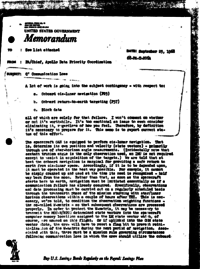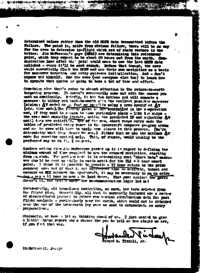See list attachedSeptember 25, 196868-PA-T-206APA/Chief, Apollo Data Priority CoordinationC’ Communication Loss
A lot of work is going into the subject contingency – with respect to:
a. Onboard cis-lunar navigation (P23)
b. Onboard return-to-earth targeting (P37)
c. Block data
all of which are solely for that failure. I won't comment on whether or not it's worthwhile. It's too emotional an issue to even consider eliminating it, regardless of how you feel. Therefore, by definition it's necessary to prepare for it. This memo is to report current sta- tus of this effort.
The spacecraft G&N is equipped to perform cis-lunar navigation. That is, determine its own position and velocity (state vectors) – primarily through use of star-horizon angle measurements. (Incidentally note that sextant trunion angle is the only observation used, an IMU is not required except to assist in acquisition of the targets.) We are told that at best the onboard navigation is marginal for providing a safe return to earth from cis-lunar space. Accordingly, if it is to be depended upon, it must be operated in the best way possible. For example, it cannot be simply cranked up and used at the time its need is recognized – half way back from the moon. Rather then that, as soon as the spacecraft starts back to earth, navigation must be initiated essentially as if a communication failure has already occurred. Specifically, observations and data processing must be carried out on a regularly scheduled basis through the transearth phase of the mission starting with star/lunar horizon observations within a couple of hours after TEI. This is nec- essary, we're told, to condition the observation weighting functions – the so-called W-matrix – so that subsequent observations are processed properly. In order to protect the W-matrix, it may be necessary to transmit the MCC-H/RTCC determined state vectors into the spacecraft computer memory locations assigned to the LM state vector which, of course, are unused on this flight. Or if uplinked into the CSM state vector slots, the crew will have to reset a flag bit to prevent reini- tialization of the W-matrix during the next period of navigation. Asso- ciated with this, there must be a mission rule governing circumstances following communication loss in which the crew should utilize the onboard determined values rather than the old MSFN data transmitted before the failure. The point is, aside from obvious failure, there will be no way for the crew to determine in-flight which set of state vectors is the better. Jim McPherson's guys (MPAD) are determining this switchover point, which they expect to be about 20 hours out from the earth. Com- munication loss after that point would mean to use the last MSFN data uplinked – cause it'll be good enough. Before that though, the crew would essentially flush the MSFN and use their own navigation as a bases for maneuver targeting and entry guidance initialization. And – don't anyone kid himself. For the crew (and everyone else too) to learn how to operate that oyster is going to take a lot of time and effort.
Something else that's going to absorb attention is the return-to-earth targeting program. It doesn't necessarily come out with the answer you want automatically. Briefly, it has two options and will compute a maneuver to either get back-to-earth with the smallest possible maneuver (minimum ΔV mode) or as fast as possible using a crew specified ΔV (min. time mode).The landing point is not controlled in the computation and, if they want to return to some particular place – like the ships – the crew must manually iterate, noting the predicted IP and adjusting ΔV until they are satisfied. Use of the new, short range entry made the tables of predicted entry range in the spacecraft computer program wrong and so the crew will have to apply some biases in this process. (We're determining what they should be now.) Either that or use the minimum ΔV mode for corridor control only. This, of course, would usually be the preferred way to do it. I suspect.
Another action item Jim McPherson picked up is in regard to defining the minimum amount of time required to use the onboard navigation, starting from scratch. The problem here is in determining what “Block Data” maneu- ver should be sent up while in earth orbit for the TLI + 4 hour abort point. I think it is possible to provide a 17 hour return to the prime recovery area but if that is not sufficient time to navigate, target and execute an MCC onboard the spacecraft, it may be necessary to go an extra day – say a 41 hour return – to land there. That goes against the grain doesn't it, but that's where the no-communication logic led me!
Incidentally, all translunar navigation, as such, has been deleted from the flight plan. Essentially, all that is currently included are a series of observational periods to gather raw sextant star/horizon data for post flight analysis – particularly near the earth, which could not be obtained near the end of the transearth leg when we want to concentrate on entry preparations.
Obviously, we have a lot of thinking ahead of us. I just wanted to give a little status report and a chance for you to tell us how stupid we are, if you feel that way.
- Oct 22, 1968 – C’ Spacecraft Navigation Mission Techniques (4.3σ)
- Oct 17, 1968 – Transearth Spacecraft Navigation (4.0σ)
- Nov 21, 1968 – C’ entry initialization with no communication (3.1σ)
- Oct 18, 1967 – There will be no manual input of range data capability in spacecraft rendezvous navigation (3.1σ)
- May 12, 1969 – Cis-lunar state vector updating procedure change (3.0σ)


